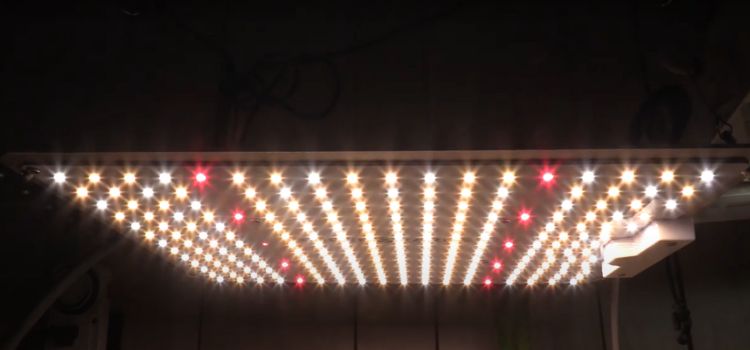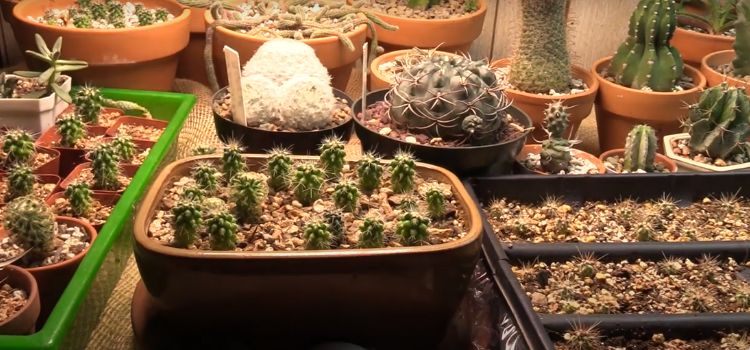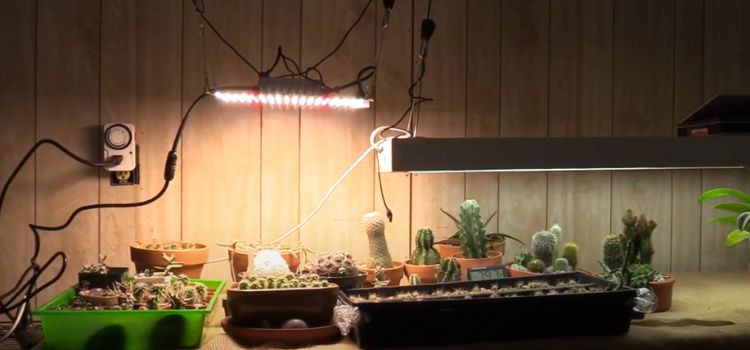As an Amazon Associate, I earn from qualifying purchases.
Red and blue LED grow lights are ideal for cactus growth. These lights support photosynthesis and promote healthy development.
Cacti thrive under specific light conditions that mimic their natural habitat. Red and blue LED grow lights provide the optimal light spectrum for photosynthesis. Red light promotes flowering and fruit production, while blue light encourages vegetative growth. Using these lights ensures that your cactus gets the right balance of light for healthy development.
Proper lighting is crucial for cacti, as insufficient light can lead to weak, elongated growth. Investing in quality grow lights can help your cactus thrive indoors, even in low natural light conditions. This approach ensures your cactus receives the right light spectrum for robust growth and vibrant health.
Cactus Lighting Needs
By learning about their natural habitat and how they adapt to different light conditions, you can select the perfect grow light for your cactus.
Natural Habitat Of Cactus
Cacti are native to deserts and arid regions. They grow in places with intense sunlight and extreme temperatures. Understanding their natural habitat helps us mimic those conditions indoors.

Key features of a cactus’s natural habitat include:
- High Light Intensity: Cacti receive sun exposure, often more than 12 hours daily.
- Low Humidity: Deserts have deficient humidity levels, which cacti are adapted to.
- Extreme Temperatures: Daytime temperatures can be very high, while nighttime temperatures drop significantly.
Adaptation To Different Light Conditions
Cacti are incredibly resilient. They can adapt to various light conditions. Indoors, they need to grow lights to simulate their natural sunlight exposure.
Grow lights should provide:
- Whole Spectrum Light: Mimics natural sunlight, essential for photosynthesis.
- Blue Light (400-500 nm): Encourages healthy growth and development.
- Red Light (600-700 nm): Promotes flowering and fruiting in cacti.
When selecting the appropriate grow light for your cacti, it’s vital to grasp the significance of light wavelengths:
| Light Type | Wavelength Range (nm) | Benefits |
|---|---|---|
| Blue Light | 400-500 nm | Healthy Growth |
| Red Light | 600-700 nm | Flowering and Fruiting |
| Full Spectrum | 400-700 nm | Overall Health |
Providing the right combination of blue and red light ensures your cactus gets the proper care it needs.
Types Of Grow Lights
Cacti need special care, especially indoors. Choosing the right grow light colour can help them thrive. Various types of grow lights are available, each with unique benefits. Understanding these types enables you to select the best one for your cactus.
Full Spectrum Grow Lights
Full spectrum grow lights mimic natural sunlight. These lights contain all the colours of the light spectrum. They are versatile and support all stages of plant growth. Here’s why full-spectrum grow lights are a good choice for cacti:
- Complete Light Range: They provide a balance of cool and warm light. This supports photosynthesis and healthy growth.
- Energy Efficiency: LED full spectrum lights use less electricity. They are cost-effective and environmentally friendly.
- Easy to Use: These lights are simple to set up and maintain. They are suitable for both beginners and experienced gardeners.
Here is a comparison table showing the pros and cons of full-spectrum grow lights:
| Pros | Cons |
|---|---|
| Supports all plant stages | Can be more expensive upfront |
| Energy-efficient | May require proper positioning |
| Easy to use | Some models may produce heat |
Specific Color Grow Lights
Specific colour growth lights focus on particular parts of the light spectrum. They target specific growth phases. Here are the common types of particular color grow lights for cacti:
- Red Light: Red light promotes flowering and fruiting. Cacti need this light during their blooming phase.
- Blue Light: Blue light encourages vegetative growth. It helps cacti produce strong stems and healthy roots.
- Green Light: Green light assists in overall plant health. It penetrates deeper into the plant canopy.
Advantages of using specific colour grow lights include:
- Targeted Growth: They focus on specific growth stages. This ensures optimal development.
- Customization: You can mix different lights. This allows you to create the perfect growth environment.
- Cost-Effective: Often cheaper than full spectrum lights. They are suitable for targeted applications.
Here is a summary table:
| Colour | Purpose |
|---|---|
| Red | Promotes flowering |
| Blue | Encourages vegetative growth |
| Green | Supports overall health |
Both full-spectrum and specific-color grow lights have unique benefits. Your choice depends on your cactus’s needs and growth stage.
Effects Of Different Color Spectrums
Choosing the right colour to grow light for your cactus can significantly affect its health and growth. Different colour spectrums have unique effects on plants. Understanding these effects helps you select the best grow light for your cactus.
Red Light Spectrum
The red light spectrum is the secret to the growth and flowering of cacti. Ranging from 620 to 750 nanometers, red light is the catalyst for photosynthesis and the development of your cactus’s most beautiful and productive parts- the flowers and fruits.
Critical Benefits of Red Light for Cacti:
- Stimulates flowering: Red light encourages cacti to produce flowers, enhancing their beauty.
- Boosts photosynthesis: Red light aids in photosynthesis, providing growth energy.
- Supports stem growth: Red light helps elongate stems and improve plant structure.
Blue Light Spectrum
The blue light spectrum ranges from 450 to 495 nanometers. It is vital for the vegetative growth of cacti. Blue light helps in the development of strong stems and leaves.
Key Benefits of Blue Light for Cacti:
- Promotes vegetative growth: Blue light helps grow stems and leaves.
- Enhances chlorophyll production: Blue light boosts chlorophyll production, making cacti greener and healthier.
- Improves plant structure: Blue light helps develop a compact and robust plant structure.
Best Color Grow Light For Cactus
Cacti thrive in bright, sunny conditions, so choosing the right grow light colour is essential for their health. The best colour growth light for cacti ensures proper growth and vibrant health. Balancing the light spectrum is crucial for optimal results.
Balancing Red And Blue Light
Balancing red and blue light is vital for cactus growth. Each colour serves a specific purpose in the plant’s development. Red light is essential for flowering and fruiting. It helps the cactus produce blooms and seeds. Blue light is crucial for vegetative growth. It supports the development of strong stems and leaves.
Using a combination of red and blue lights can mimic natural sunlight. This balance ensures the cactus gets the light it needs for all growth stages. Here’s a simple breakdown:
- Red Light (600-700 nm): Promotes flowering and fruiting.
- Blue Light (400-500 nm): Encourages vegetative growth.
Full-spectrum grow lights are an excellent choice for cactus growers. They provide a balanced mix of red and blue light to mimic natural sunlight. This balance is crucial for cactus growth, ensuring healthy and strong growth.
| Light Type | Purpose |
|---|---|
| Red Light | Flowering and Fruiting |
| Blue Light | Vegetative Growth |
| Full-Spectrum Light | All Growth Stages |
Balancing red and blue light ensures your cactus gets the best of both worlds. It supports the plant through all stages of growth. This balance leads to a healthier and more vibrant cactus.
Considerations For Different Growth Stages
Cacti have different light needs at various growth stages. Seedlings and young plants need more blue light. This light encourages solid stems and healthy leaves. As the cactus matures, red light becomes more critical. This light supports flowering and fruiting.
Here’s a simple guide for different growth stages:
- Seedlings: High blue light (450-500 nm) for solid growth.
- Young Plants: Balanced blue and red light for overall health.
- Mature Plants: Increased red light (600-700 nm) for blooming.
Adjusting light intensity is also essential. Seedlings require less intense light. Too much sunlight can damage young plants. Mature cacti can handle more intense light. This intensity helps them produce flowers and seeds.
| Growth Stage | Light Type | Light Intensity |
|---|---|---|
| Seedlings | Blue Light | Low |
| Young Plants | Balanced Blue and Red Light | Moderate |
| Mature Plants | Red Light | High |
Monitoring growth stages helps adjust the light. This ensures the cactus gets the right light at the right time, leading to a thriving cactus at each stage of its life.

Setting Up Grow Lights For Cactus
Cacti are unique and fascinating plants that thrive in bright, sunny conditions. But what if you live in an area with limited sunlight? Grow lights can help your cacti get the light they need to stay healthy. Setting up grow lights for cacti involves understanding the correct colour, placement, and schedule. These factors ensure your cactus receives the optimal light for growth and health.
Placement And Distance
Proper placement and distance of grow lights are crucial for your cactus’s well-being. Cacti need intense light to mimic their natural desert environment. Follow these tips to ensure your cactus gets the best light:
- Place the grow light directly above the cactus. This simulates the sun’s position in the sky.
- Maintain a 6 to 12 inches distance between the light and the cactus. This distance provides ample light without damaging the cactus.
- To maximize light exposure, use a reflective surface around the cactus. Aluminium foil or a reflective grow tent works well.
- Check the light’s intensity. Use a light meter to ensure your cactus receives 2,000 to 3,000 lumens.
Adjust the distance based on the light’s intensity. Higher-intensity lights can be placed further away, while lower-intensity lights need to be closer. Monitor your cactus’s response to the light. If you notice signs of sunburn or bleaching, increase the distance. If the cactus appears to be stretching or leaning, decrease the distance.
Lighting Schedule
Creating a consistent lighting schedule is critical to your cactus’s health. Mimic the natural daylight cycle to keep your cactus happy. Here are some steps to follow:
- Provide 12 to 14 hours of light during the growing season (spring and summer). This encourages healthy growth and flowering.
- Reduce light exposure to 8 to 10 hours during the dormant season (fall and winter). This allows the cactus to rest.
- Use a timer to automate the lighting schedule. Timers ensure your cactus receives consistent light without manual intervention.
Monitor the cactus’s growth and adjust the schedule if needed. Signs of insufficient light include pale colour and elongated growth. Signs of too much light include brown spots and a scorched appearance. Consistency is vital for a healthy cactus. Stick to the schedule and make gradual adjustments as needed.
Frequently Asked Questions
Cacti thrive under full-spectrum light, which mimics natural sunlight. Use grow lights labelled “full-spectrum” or “daylight” for best results.
The best light colour for succulents is a combination of red and blue. Red light promotes flowering, while blue light supports leaf growth. Balanced light ensures healthy succulents.
For optimal growth, cacti need 12-14 hours of LED light daily, which should mimic natural sunlight.
What Color Should I Set My Grow Lights To?
Set grow lights to blue for vegetative growth and red for flowering. Use a mix for full-spectrum growth.
Conclusion
Choosing the right light colour is crucial for healthy cactus growth. Blue and red spectrum lights are ideal. Remember, proper lighting ensures vibrant, thriving cacti. Experiment with different light intensities to find the perfect balance. Happy growing!

